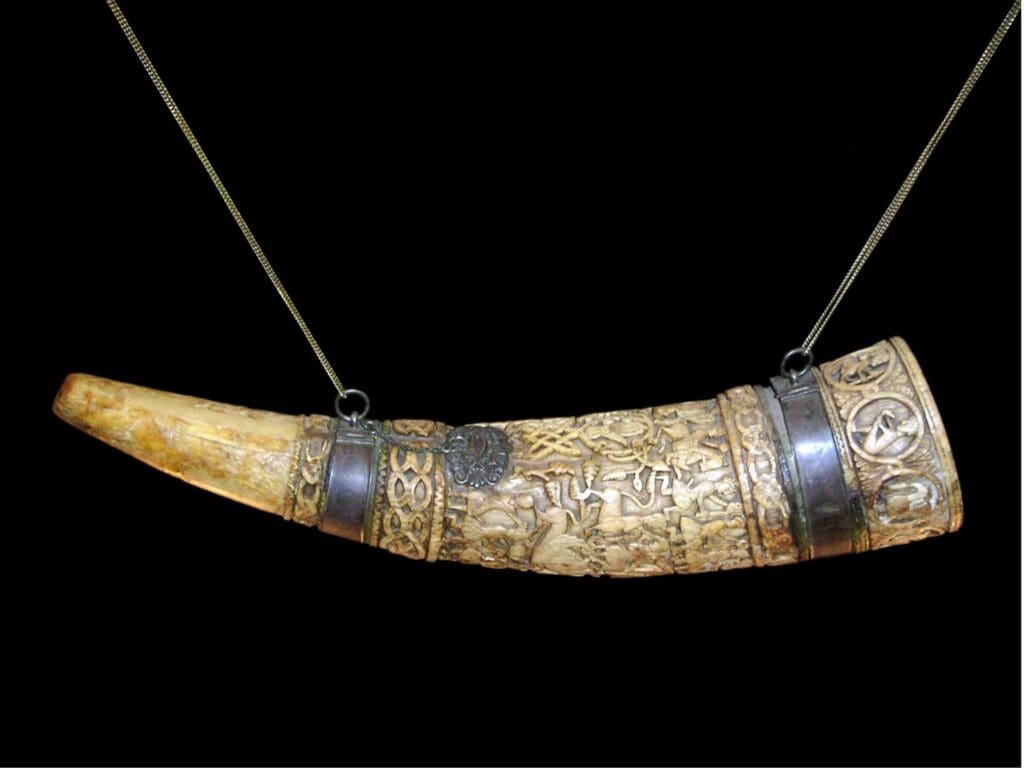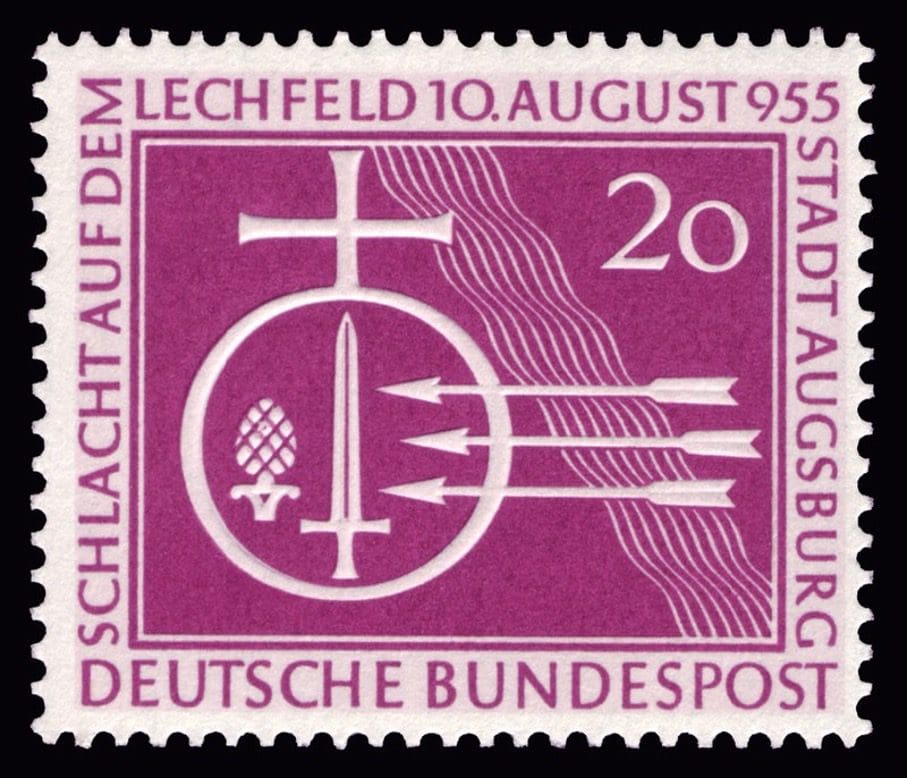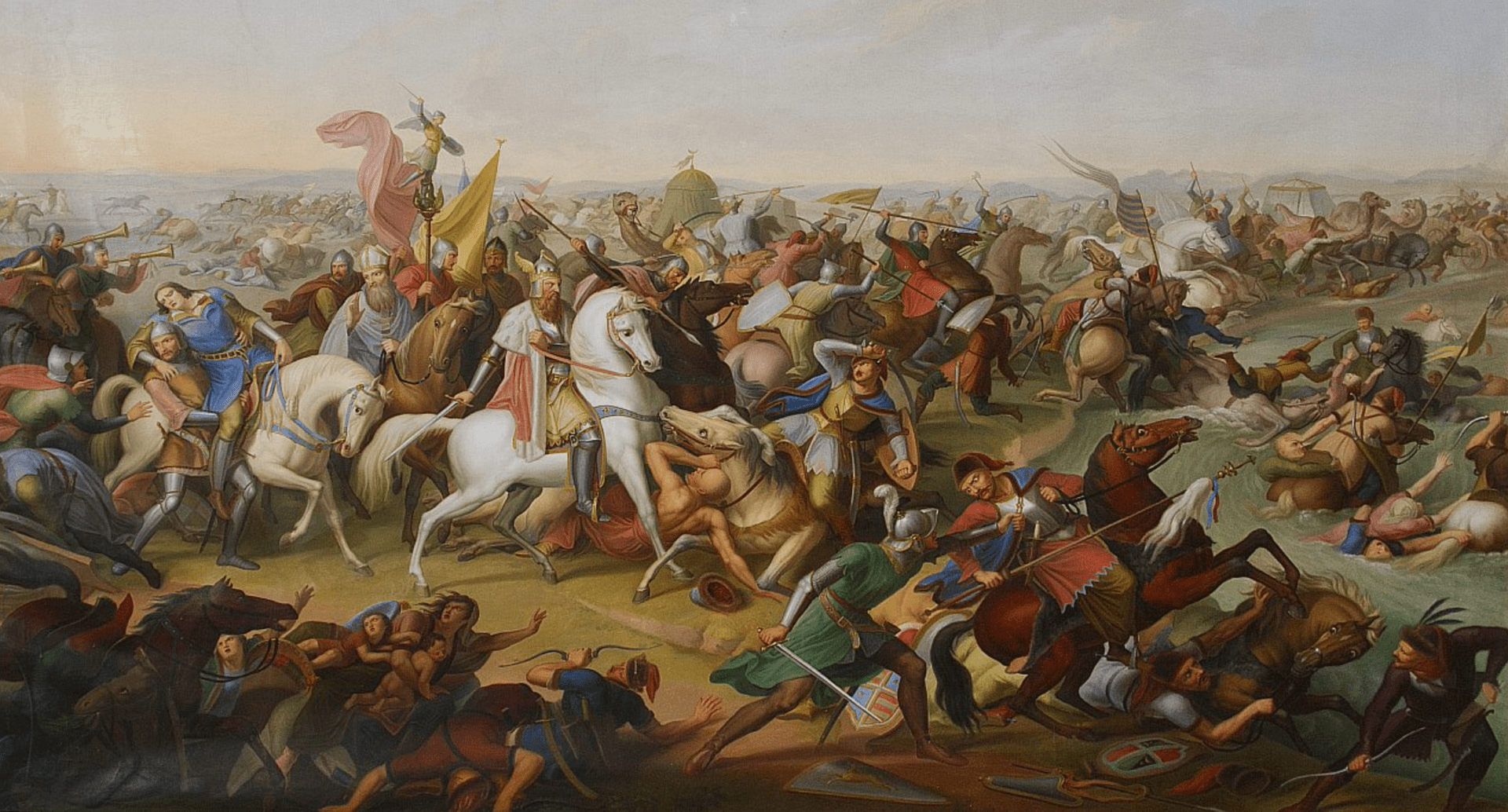There are few campaigns in military history that both the winners and the defeated look back on with satisfaction. Such is the battle fought between the German and Hungarian forces on the banks of the River Lech near Augsburg on 10 August 955, the day of Saint Lawrence, a martyr deeply respected by Christians. The troops of the German Duchies led by Otto I (Otto the Great), King of Germany, inflicted a decisive defeat on the nomadic Magyar horsemen who had been terrorizing the whole of Europe since 900. The German victory ended the Hungarian raids into Western Europe, opening the way for King Otto to be crowned Holy Roman emperor in 962, which he made even more memorable by founding further bishoprics and archbishoprics in Germany.[1]
The campaign of 955 did not start unfavourably for the Hungarians. The German internal fighting raged on in the previous year, with German dukes and nobles competing with one another for the support of the Hungarians. However, the situation quickly changed—in 955, the Hungarians were left to their own devices. What we already know for certain is that the Hungarians had surrounded the town of Augsburg by 8 August. The town was probably not defended by a significant military force, still, under the leadership of Ulrich, Bishop of Augsburg, who was later canonised as St Ulrich, the town successfully organised its defence until the German relief army arrived.
The open field battle began with the attack of the Hungarians—they had crossed the River Lech and got behind the German army. However, King Otto sent the most experienced and best-equipped royal legion against the Hungarians, which put them to flight. The German victory became complete when the retreat of the enemy was cut off, and that is when the Magyars suffered a massive blood loss. The leaders of the fleeing army, Lehel and Bulcsú, who had been baptised in Byzantium before, were captured and soon hanged in Regensburg. The German victory was also the subject of contemporary Latin songs, and German chroniclers preserved its memory as the best-documented military historical event of the 10th century.

The defeat most probably shocked Hungarians at the time—proof of this is the story of the horn of Lehel recorded in Hungarian chronicles. According to the legend, one of the captured Hungarian leaders, Lehel, struck the German ruler dead with his horn. Although the ruler is named incorrectly in the story—he is called emperor instead of king and Konrád instead of Otto (perhaps like Fritz today, all Germans were called Konrád by the Hungarians at the time)—, it undoubtedly originated in the period prior to the adoption of Christianity. Thanks to this legend, the grave Hungarian defeat was embellished and embedded in Hungarian historical memory as a sort of victorious episode.
As Hungarian chroniclers put it: ‘In this place the illustrious captains Lél [Lehel] and Bulcsú were made captive and brought before the emperor. When he asked them why they were so cruel towards the Christians, they replied: “We are the great God’s vengeance, destined by Him to be a scourge unto you, and therefore we are captured and slain by you when we cease to persecute you.” To which the emperor replied: “Choose what death you wish to die.” Lél said to him: “Let my horn be brought to me, and when I have blown a blast upon it I will answer you.” So his horn was brought to him, and coming near to the emperor he made as if to blow it, and then with his horn he smote the emperor so strongly upon the forehead that with that single blow the emperor was dead. “You shall go before me,” he said to him, “and will be my slave in the other world,” for the Scythians believe that whomsoever they kill in their lifetime, these are obliged to serve them in the next world.’[2]
After the legend was born, the horn really came to life. A 12th-century Byzantine ivory horn showed up as the horn of Lehel in the 17th century in the Hungarian city of Jászberény. After that, city residents integrated the story into their own historical tradition—the horn was originally kept in the local church, then, from the beginning of the 19th century, in the city hall. The captain of the Jász, the local privileged ethnic group also took it with him to Buda on the occasion of the coronation of King Franz Joseph I in 1867. The piece missing from the edge of the horn is believed to have broken off when Lehel struck the German ruler with it. Thanks to the power of the legend, researchers considered the horn an authentic relic of the Battle of Lechfeld until the second half of the 19th century, and the memory of the defeat was replaced for good by the story of the horn of Lehel.
Most historians agree that the battle’s consequences led Hungarian history down a new path a few decades later
Beside the medieval Hungarian chroniclers, modern-day Hungarian historians also take a rather positive view of the defeat, as they see the defeat as the establishment of the conditions for the Magyars to join Christian Europe and for the subsequent Hungarian-German rapprochement. Most historians agree that the battle’s consequences led Hungarian history down a new path a few decades later. And indeed, after the battle, it did not even take half a century for the establishment of the Latin Christian Church in Hungary, while Gisela of Bavaria, the wife of the first Hungarian king, Saint Stephen, was the sister of King Henry II of Germany, who ascended the throne in 1002.
In Augsburg, the battle has been an important part of the city’s historical memory since the Middle Ages. Its remembrance was kept alive by the city chronicles, but especially by the Church, which has several relics associated with St Ulrich. This was of great importance for the survival of the tradition, since without a religious connection, such great anniversaries would sooner or later have faded away. Thus, until 1803, 4 July, the memorial day of St Ulrich, was marked as a National Day of Remembrance in the Bishopric of Augsburg.
Attention was mostly focused on the most famous relic of St Ulrich preserved in the city, the so-called ‘cross of victory’, the Crux victorialis, which is credibly connected to the character of the bishop. St Ulrich’s grave was opened in 1183 after a fire, and that was when the wooden cross later revered as the ‘cross of victory’ was found, which, according to the medieval legend, was brought down from heaven by angels for the bishop when he was fighting in the battle.
From the beginning of the 17th century, a mural on the wall of the former guildhall of weavers in Augsburg (Weberhaus in German) captures the events of the battle. In this mural, the Germans are marching under their battle flag, with a Hungarian warrior fleeing from them and shooting arrows backwards. Above the Germans, Saint Michael the Archangel stands with a drawn fiery sword in a hand, and a devil figure, representing the Hungarians, flees from him.
What was originally a battle of regional significance was thus elevated to the rank of a national historical event by the 19th century, and the phrase ‘Battle of Lechfeld’ itself was born at that time as well.[3] This reflected the suddenly increased prestige of the army and military history in Imperial Germany, where historical events like the great victory that founded the German Empire in the Middle Ages were eagerly researched. In terms of the interpretation of the battle, special emphasis was placed on the regaining of the Eastern border region of the empire, Ostmark, after 955. As far as the commemorations and historical representations of the battle are concerned, obvious differences can be observed depending on whether the secular (those associated with Otto I) or the ecclesiastical (those associated with St Ulrich) components are highlighted or ignored, and whether the pan-German and regional aspects are stressed. It is also remarkable that on the 900th anniversary of the battle, in 1855, the foundation stone of the church commemorating the victory was laid in a grand, historical re-enactment procession at Königsbrunn, ten kilometres from Augsburg, which is the presumed scene of the battle.

In 1955, on the 1000th anniversary of the battle, a significant event took place again—although not in Hungary, where more important things were happening in daily politics at the time. However, the year 1955 can be considered a turning point in German history: the country regained its sovereignty after its defeat in World War II, and it also joined NATO.[4]German politicians concluded that since Germany played a decisive role in the creation of a united Europe, despite the events of WWII, it has a moral right to rearm itself in order to fight against Bolshevism and Asian ideals. The first chancellor of the Federal Republic of Germany, CDU politician Konrad Adenauer, explicitly mentioned the importance of Western Christian culture in his speeches at the time—thus, it is not by chance that the Christian West sought role models and historical figures such as Holy Roman Emperors Charles the Great, Otto I, or Charles V. At the same time, the Protestant circles of the CDU, not to mention the Social Democrats, assigned a much smaller role to Christianity, and even CDU politician Hermann Ehlers, the President of the Bundestag, did not support equalling Europe with the Christian West.
Round anniversaries offered an excellent opportunity to revive German historical self-consciousness, and to celebrate historical figures and events. It all began in 1946 in Bamberg with the celebration of the 800th anniversary of the canonisation of Emperor Henry II, followed by the 700th anniversary of the construction of the Cologne Cathedral, then in 1954, by the 1200th anniversary of the birth of Saint Boniface, the English Benedictine monk who converted the Germans. Finally, the series of events culminated in the 37th International Eucharistic Congress in Munich in 1960.
In Germany, the victory of 955 was also commemorated with the issuing of special stamps. Even though saner voices warned against the endless drawing of parallels with the present and attributing all evil to the East, what set the tone for the event was still the Cold War: the 10th-century attack by pagan Hungarians was identified with the 20th-century Bolshevik advancement and the looming spectre of a Soviet aggression.
A festive week in honour of St Ulrich was held, which ended with the ‘Days of the Western Confession’
The main organiser of the commemoration of the Battle of Lechfeld was the Catholic Church, or more precisely the Bishopric of Augsburg, which designated the year 1955 the ‘Year of Ulrich’. In July of that year, a festive week in honour of St Ulrich was held, which ended with the ‘Days of the Western Confession’ (Tage abendländischen Bekenntnisses). Understandably, the celebrations were not adjusted to the day of the battle (10 August), as they were in 1855, but to 4 July, the Remembrance Day of the canonised bishop, which was close enough to the day of the battle. Every day of the festive week was made memorable by church processions and theatre performances such as the Augsburg Millennium Play. In the play, the Hungarians were represented by the devil, similarly to the mural on the wall of the Weberhaus.
The long series of speeches of the festive week, which dealt with the victory of Christianity and the importance of Catholicism instead of history, and stood out by the flashing of current political parallels, can be read in an independent publication. The most prestigious participant of the event, Robert Schuman, the French Minister of Justice at the time, was among the speakers who asserted the latter aspect: he had the forming European community in his sights, and in this sense, he also underscored the role of the empire of Charles the Great. He refrained from speaking about the relationship between Christianity and the national idea, and rather argued for limiting the sovereignty of individual countries for the sake of a future European association. However, the similarity between the pagan Hungarians who arrived under the city walls in 955 and the ‘masses of the east’ (Massen des Ostens) threatening the West in 1955 was obvious to the freshly debuting German Foreign Minister Heinrich von Brentano, who evaluated West Germany’s accession to NATO in this context.[5] At the rally, which drew a crowd of 60,000, the minister, also mentioning the Austrian State Treaty, optimistically pointed out that with the courage of St Ulrich, the modern descendants of the 10th-century ‘nomadic hordes’ could successfully defend the Western border area, too. Since he used the terminology of the conservative Abendland (Western World) ideology, which also condemned materialism, the liberal press was not pleased with it—they ironically likened it to the harsh speech of Emperor Wilhelm II, the so-called Hunnenrede (Hun Speech), which he gave to his troops leaving for China on 27 July 1900 in Bremerhaven, and which scandalised many of his contemporaries.[6]
Among the speakers was the former Hungarian General Emil Justhy, living in exile in Germany, for whom it was not easy to deliver a speech: he said wittily that he was passing on the greetings of the descendants of Hungarians who, as pagans, were once the most horrible and terrifying enemies of the Germans, but who later became their reliable brothers in arms for a millennium. He adroitly brought up the examples that proved the sacrifices and heroic deeds of the Hungarians in the defence of Europe—in his speech, historical examples abounded. The former General jumped from King Saint Ladislaus, who was chosen as the leader of the First Crusade, to the Siege of Belgrade (Nándorfehérvár in Hungarian) in 1456, where, according to him, St Ulrich’s Hungarian counterpart was John Hunyadi, the captain-general of Hungary, and finally, to the Battle of Mohács fought against the Ottomans in 1526.
Of course, at the time, the participants of the celebrations could not have known that a year later the Hungarian Revolution of 1956 would fundamentally change the image of Hungarians in Western Europe, and the term Massen des Ostens would acquire a completely new meaning.
[1] Charles R. Bowlus, The Battle of Lechfeld and its Aftermath, August 955: The End of the Age of Migrations in the Latin West, London: Routledge, 2006.
[2] János M. Bak, László Veszprémy (ed.), Chronicle of the Deeds of the Hungarians from the Fourteenth-century Illuminated Codex, Budapest–New York, CEU Press – OszK, 2018, pp. 101-103.
[3] Maximilian Georg Kellner, ‘Die Lechfeldschlacht, ein Ereignis zwischen historischer Forschung und populärwissenschaftlicher Darstellung’, in Márta Fata (ed.), Das Ungarnbild der deutschen Historiographie, Stuttgart: Steiner, 2004, pp. 289–298.
[4] Matthias Pape, ‘Lechfeldschlacht und NATO-Beitritt. Das Augsburger “Ulrichsjahr” 1955 als Ausdruck der christlich-abendländischen Europaidee in der Ära Adenauer’, Zeitschrift des Historischen Vereins für Schwaben, vol. 94, 2001, pp. 269–308.
[5] Frank-Lothar Kroll, ‘Heinrich von Brentano. Ein biographisches Porträt’, in Roland Koch, Frank-Lothar Kroll (ed.), Heinrich von Brentano – Ein Wegbereiter der europäischen Integration, Munich: Oldenbourg, 2004, pp. 25-65.
[6] Vanessa Conze, Das Europa der Deutschen. Ideen von Europa in Deutschland zwischen Reichstradition und Westorientierung (1920-1970), Munich: Oldenbourg, 2005, pp. 162-166.








